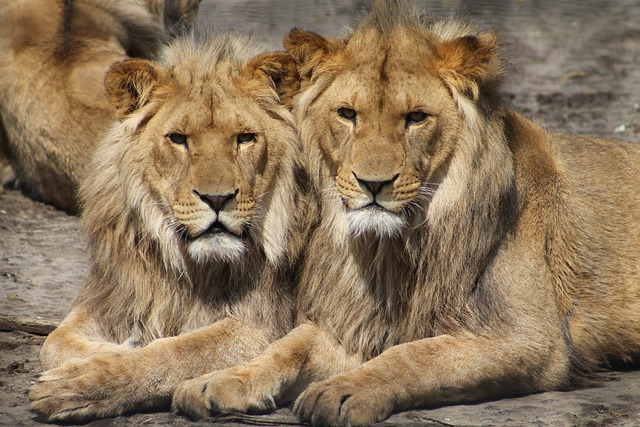10 distinctive Facts about Lions
- They Rank Second in Size: Following tigers, lions are the second-largest big cats. Adult male lions weigh up to 550 pounds, while females generally range from 265 to 400 pounds.
- Mane: A Male Feature: Male lions boast a distinct mane of hair encircling their head and neck. This mane, darker and denser in older males, is believed to shield their necks during confrontations.
- Lions in Prides: Uniquely, lions are the sole cats living in social groups named prides. These prides typically encompass related females, their cubs, and a few adult males. While males safeguard territory, females primarily hunt.
- Top Predators: As apex predators, lions stand at the apex of the food chain. Their diet comprises sizeable prey like zebras, wildebeests, and antelopes. Their cooperative hunting involves leveraging strength, speed, and teamwork.
- Roars that Resound: Lions are famed for their resounding roars, audible for up to 5 miles. These roars communicate within the pride, mark territory, and attract mates.
- Social Bonds: Lions display strong bonds within their prides. Grooming, playing, and communal resting are common ways they foster these relationships.
- Maternal Role of Lionesses: Lionesses hold the primary role in raising cubs. Nursing can extend up to 6 months, during which time they also impart hunting and survival skills.
- Threats and Vulnerability: Habitat loss, human-wildlife conflict, and poaching endanger lions. Their populations have notably dwindled, classifying them as vulnerable on the IUCN Red List.
- Ecological Significance: Lions contribute significantly to ecosystems by controlling the populations of other animals. Additionally, they generate tourism revenue for several countries.
- Cultural Symbolism: Lions have held a central place in art, literature, and mythology for centuries. They symbolize attributes such as strength, courage, and power.
‘World Lion Day’ is celebrated every year on 10th August to make people aware and educated about lions and their conservation.
World Lion Day and its Importance
The purpose of World Lion Day is to spread awareness about lions and to make efforts for their conservation, as well as to make all people aware of the “importance of lions in their natural habitat”.
Lions Population:
The current population of lions in the wild is estimated to be around 20,000 individuals. This number has been declining in recent years due to a number of factors, including habitat loss, poaching, and conflict with humans.
The vast majority of lions (around 19,000) live in Africa, with the remaining 1,000 living in India. The African lion population is concentrated in southern and eastern Africa, with the largest populations found in Tanzania, Kenya, and South Africa. The Indian lion population is found in the Gir Forest National Park and Wildlife Sanctuary in Gujarat.
Asiatic lions were once found in areas from Persia (Iran) to eastern India. By the late 1890s, the range of the Asiatic lion was restricted to the Gir Forest region of Gujarat, India. With the continuous efforts of the state and central government, the population of Asiatic lions increased from 177 in the year 1968 to 674 in the year 2023.
The initiative to conserve lions started in the year 2013 and the first ‘World Lion Day’ was also organized in the same year.
Significance:
An opportunity to understand the place or importance of lions in the ecological cycle as well as their extinction can be a dangerous signal for humans.
Lions were found in Asia, Africa, Europe, and the Middle East about three million years ago, although their numbers have declined by about 95% over the course of five decades.
Biological Name: Panthera leo
The lion is classified into two subspecies: the African lion (Panthera leo leo) and the Asiatic lion (Panthera leo persica).
Asiatic lions are smaller than African lions.
The most important morphological feature found in Asiatic lions is that they have distinctive vertical folds on the skin of their abdomen. This feature is quite rare in African lions.
Importance of Lions in wildlife
Lions hold an important position in the forest ecosystem, being the apex predator of their habitat, helping to maintain the ecological balance by controlling the population of herders.
Lions also contribute to keeping their prey populations healthy and resilient among them, as they target the most vulnerable members of the herd. Thus indirectly helps in disease control in the hunting population.
Hazard:
Poaching, genetic inbreeding from populations of the same species, diseases such as plague, canine distemper, or natural disasters.
Protection Status:
IUCN Red List: Vulnerable
Asiatic Lion: Endangered
Location in India: India is home to the Asiatic lions, which live in the protected area of Sasan-Gir National Park (Gujarat).
According to the statistics for the year 2023, the number of lions in India is 674, whose number was 284 in the year 1990.
Conservation Efforts:
Project Lion:
Introducing Project Lion, an initiative by the Indian government, aimed at safeguarding the Asiatic lion species.
Unveiled on August 15, 2020, during the 74th Independence Day celebrations by Prime Minister Narendra Modi, this endeavor falls under the purview of the Ministry of Environment, Forest and Climate Change. Drawing inspiration from the successful Project Tiger, Project Lion mirrors its framework.
The mission of Project Lion encompasses four primary objectives:
- Enhancing the wild population of Asiatic lions.
- Establishing a secondary lion population within Madhya Pradesh’s Kuno National Park.
- Mitigating conflicts between local residents and lion populations.
- Elevating the overall management of the Asiatic lion habitat.
To facilitate breeding, Project Lion has designated three “gene pool” sites: Rampara in Saurashtra, and Sakkarbaug and Satveerada in Junagadh.
Notably, the project envisions infrastructural improvements for the Gir National Park and Wildlife Sanctuary. These enhancements encompass the construction of new roads, fencing, and provisioning of better sustenance and water sources for the lions.
Stretched across a significant time frame, Project Lion is a long-term undertaking. While its full ambitions may take years to realize, the initiative is paramount for the conservation of the critically endangered Asiatic lion.
Supplementary Insights into Project Lion:
– The anticipated cost of the project stands at approximately Rs 1,000 crore (equivalent to US$130 million).
– The project’s execution will unfold over a span of 10 years.
– Generating employment opportunities, the initiative is projected to create around 10,000 jobs.
– Furthermore, the initiative is poised to invigorate tourism in the Gir region.
Project Lion signifies a monumental stride in safeguarding the Asiatic lion. With substantial funding and well-defined objectives, the project carries the potential to avert the extinction of this remarkable species.
Asiatic Lion Conservation Project
The Asiatic Lion Conservation Project stands as a governmental endeavor within India, with the aim of preserving the Asiatic lion species. Unveiled on August 15, 2020, during the 74th Independence Day festivities by Prime Minister Narendra Modi, this initiative falls under the jurisdiction of the Ministry of Environment, Forest and Climate Change, drawing inspiration from the blueprint of Project Tiger.
This project is guided by four primary objectives:
- Augmenting the wild population of Asiatic lions.
- Establishing a secondary lion population within Madhya Pradesh’s Kuno National Park.
Wildlife (Protection) Act 1972
The Wildlife (Protection) Act of 1972 stands as a pivotal enactment by the Indian Parliament aimed at safeguarding the diverse flora and fauna. It represents a cornerstone in India’s efforts towards wildlife conservation.
This legislation offers a shield for an extensive array of wild animals, birds, and plants. Additionally, it places a prohibition on activities like hunting, trading, and possession of wild animals and their derivatives unless authorized by a license.
The Act also lays the foundation for a network of safeguarded regions, encompassing national parks, wildlife sanctuaries, and zoological parks.
Since its inception, the Wildlife (Protection) Act of 1972 has undergone multiple amendments, the most recent being in 2006.
Notably, the Act has yielded success in safeguarding numerous species from the brink of extinction. However, the journey of wildlife conservation in India encounters a series of challenges, including habitat degradation, poaching, and illicit wildlife trade.
Key facets of the Wildlife (Protection) Act of 1972 include:
– A prohibition on hunting wild animals, except for specific instances like self-defense or scientific research.
– A ban on the trade of wild animals and their derivatives without a valid license.
– The establishment of a network of secure zones such as national parks, wildlife sanctuaries, and zoological parks.
– The creation of the Wildlife Crime Control Bureau tasked with investigating and prosecuting wildlife-related crimes.
– The establishment of the Central Zoo Authority, responsible for regulating zoos across India.
The Wildlife (Protection) Act of 1972 occupies a significant role in India’s commitment to wildlife conservation, having contributed to the protection of numerous species and ecosystems. However, persistent challenges require attention to ensure the sustained survival of India’s wildlife.
Main challenges to wildlife conservation in India:
- Habitat Loss: The rapid expansion of India’s human population has led to the deterioration of natural habitats, posing a significant threat to wildlife.
- Poaching: Illegally hunting wild animals for their meat, fur, or other parts remains a grave concern, particularly endangering rare species.
- Illegal Wildlife Trade: The illicit trade in wildlife products like ivory, rhino horn, and tiger skin is fueled by global demand and poses a substantial challenge.
- Human-Wildlife Conflict: Instances of conflict between humans and wild animals, often arising from competition over resources, have the potential to result in casualties on both sides.
These challenges collectively underscore the urgency to address multifaceted issues and ensure the enduring existence of India’s diverse wildlife.
Conclusion
We have tried to cover all the points related to “Lions: The Iconic Large Cats” and have also shared important questions at the end. But still any kind of suggestion or update and if you see any mistake, then you must tell us.
We will try our best to update your suggestion or any mistake which happened somewhere in the post.
Thank you very much for giving your valuable time. Have a nice online journey.









